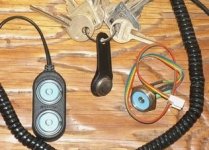Well, that 'display/controller' doesn't really have a Dallas Button port, just a one wire LAN port, which is what I suggested in an earlier post for the controller, for temperature monitoring. After the idea occurs to me though, I like the idea of including one in the handlebar unit. Here's a pic for those of you who don't know what I'm talking about. A button in a keychain adapter, a two button unit for the home PC, and the through hole unit we would probably use here, includes an LED so it's easy to find in the dark, and so the programer can signal the user that transfer was successful.

<edit> And since each button, whether its flash memory, or a real time clock, has it's own unique serial #, any one button can be given it's own set of 'permisions'. You could have a button that only allowed the bike to go 1000m from it's starting position at a set power limit, so you could let people ride without worrying about the bike coming back, or they're killing themselves!
Yea, Alan, the serial to the BMS(s) should have been at the top of the list! Do you have your BMS designed yet? Mine would use a pic, out of habit, but?

I also intend a very simple board that can control lights (tail, turn, stop, head, hi head (halon?), strobe), but could also be used for delta/wye, serial/parallel (batt or motor), or for main power contactors (none of which I intend to use, but for anyone who did, it's there)
Jeremy, the reason I might consider a power contactor would be to make battery connection idiot proof. The processor would make sure the caps were charged through the same resistor its getting power through before it closed the mains.
If we have 5000uF+ @ <10mOhm, and 20Ah 30C LiPo, and plug the batteries in, we get a LOT of current for a very short while! I don't think I could/would do that. If I'm that wasted, I don't fool with guns, dynamite, or, when/if I can afford them, LiPo.

My intention when I have real batteries to worry about is to use a precharge connector (and to leave the dangerous things on the shelf or parked on those rare occasions when under the influence).
I do like the idea of a quick disconnect, especially during prototyping.
To Alan, I saw Sparkfun had GPSs, but where are the compasses, (with tilt and trim)?

Available elsewhere, but I wonder that they don't have them. I would like to have that in addition to the GPS. Either could be implemented with a(the) simple serial interface.
The drivers I suggested do have shoot through for themselves, but if we use individual drivers for each fet, we almost have to design our own shoot through protection, I would think. In order to have built in shoot through protection, you almost have to have a driver with both high and low outputs such as the MAX15018, don't you?



